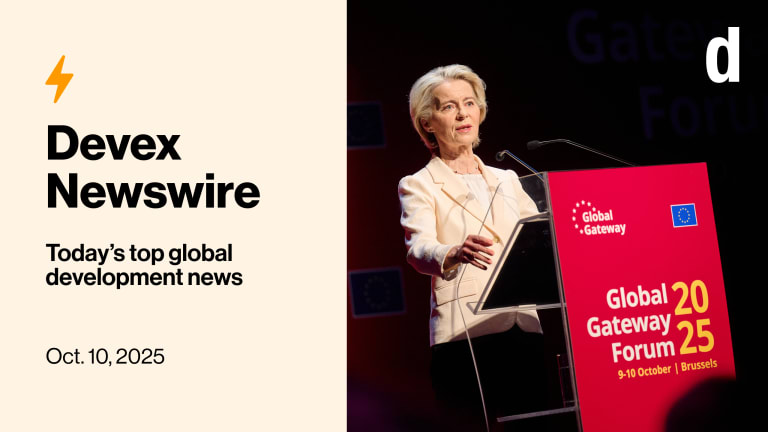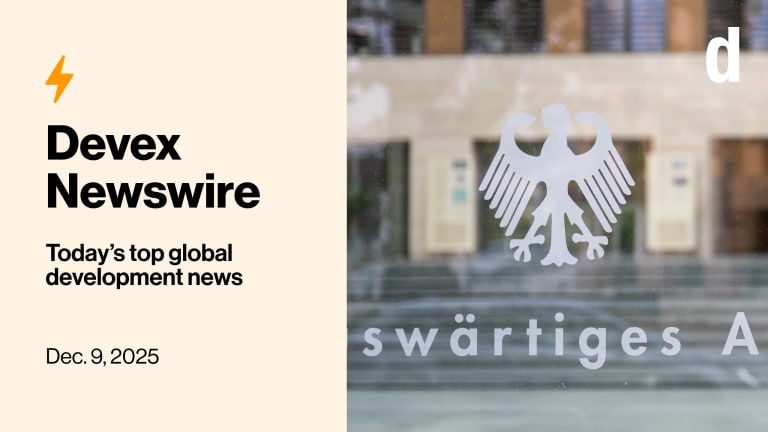
The fall of Bashar al-Assad left Syria in turmoil, with the militant group Hayat Tahrir al-Sham seizing power as millions remain displaced. Humanitarian aid is strained as 90% of Syrians face poverty, with calls for sanctions relief to enable aid delivery. The United Nations urges inclusive peace talks amid ongoing conflict, warning of a fleeting chance to support Syria’s recovery.
Also in today’s edition: We look at Syria’s aid needs over the last decade and offer career information for Afghanistan and Gaza. Plus, how artificial intelligence can help with malaria in Uganda.
+ Listen: For the latest episode of our weekly podcast series, Devex’s Michael Igoe and Adva Saldinger are joined by the World Bank’s Aly Rahim to discuss the bank’s latest civil society initiative and the International Development Association replenishment’s final tally.
Survival, sanctions, and uncertainty
This is a preview of Newswire
Sign up to this newsletter for an inside look at the biggest stories in global development, in your inbox daily.
The fall of Bashar al-Assad sparked celebration, but reality hit hard. Some 500,000 lives lost, 3.5 million homeless, and another million displaced in a decade of civil war even before rebels surged into Damascus. Refugees are trickling back from Lebanon, unsure if home still exists. The new power in Damascus? Hayat Tahrir al-Sham, or HTS, a U.N.-sanctioned terrorist group.
With 90% of Syrians living in poverty and winter closing in, aid agencies are stretched thin. Amy Pope, director-general of the International Organization for Migration, is appealing for $30 million to provide winter relief, sanitation, and health support.
Politically, Syria's chaos isn't over, writes Devex Senior Global Reporter Colum Lynch. Israel launched strikes, Turkey backs rebels, and armed groups with U.S. and regional ties are jockeying for control. The U.N. is calling for peace talks that include every player — even armed groups like HTS — signaling a possible shift similar to how it dealt with the Taliban.
Sanctions are another hurdle. They threaten to strangle Syria’s recovery just as it’s trying to stand. Aid groups face a “chilling effect” on delivering aid to HTS-controlled areas, and humanitarian workers say it’s time for sanctions relief to allow aid and commerce.
On the ground, U.N. agencies like the World Food Programme are working fast. WFP has already served 40,000 people with ready-to-eat meals. But operations face looting, price spikes, and broken supply chains. Meanwhile, more than 600,000 refugees have returned from Lebanon, but as one U.N. official puts it, they’re going back, but back to what?
U.N. envoy Geir Pedersen says there’s a “new dawn” in Syria, but it won’t last long. “There is real opportunity for change, but this opportunity needs to be grasped by the Syrians themselves and supported by the U.N. and the international community,” he says. The message is clear: The world has a fleeting chance to help Syria rebuild, and action must come fast.
Read: UN charts Syria aid course in nation run by terrorists
+ The events in Syria have once again laid bare the dire state of global humanitarian need. Today, as part of the Global Humanitarian Policy Forum, Devex President and Editor-in-Chief Raj Kumar will lead a fireside chat with U.N. relief chief Tom Fletcher. Register now to join the conversation online.
Syria’s decade of chaos
Syria's civil war may have toppled Assad, but it left behind chaos. With HTS now in control, poverty, disease, and hunger still run rampant. Since the war began in 2011, refugees have been flooding into neighboring countries, while aid funds struggle to keep up.
Over the last decade, the United Nations has sought over $100 billion for two major plans: the Humanitarian Response Plan, or HRP, which aids people still in Syria, and the Regional Refugee Response Plan, or 3RP, which supports refugees abroad. But with just $60 billion in funding secured, millions remain in need. The United States, Germany, and the United Kingdom have been top donors, but the gap keeps growing.
Now, out of a population of about 23.5 million, 16.7 million Syrians need help, but aid is falling short. Out of the $4.1 billion required for the HRP this year, only 31.6% has been funded. The world faces a choice: Keep up the support or watch Syria's “new dawn” fade.
Our Alecsondra Kieren Si brings you the humanitarian aid in numbers.
Read: A look into a decade of aid for Syria (Pro)
+ Not yet a Devex Pro member? Start your 15-day free trial today to access all our expert analyses, insider insights, funding data, exclusive events, and the Pro Insider — a special Sunday newsletter covering our industry’s big moves for Pro members.
Navigating Afghanistan’s career landscape
Since the Taliban's return to power in Afghanistan in 2021, the country has faced tightening restrictions, especially for women, and a significant drop in international aid.
This has left a gap that NGOs are eager to fill, despite the complexities of operating under a regime that censors the media and restricts freedom. With 17.3 million people in need of help, aid organizations are on the lookout for seasoned professionals who can handle the dual challenges of humanitarian aid and development work.
Recruiters are particularly keen on candidates with experience in fragile contexts who can navigate a setting where development and emergency response go hand in hand. There's a high demand for expertise in climate change resilience and, despite the constraints, an increasing push to hire capable female professionals who can engage with the community effectively.
But living and working in Afghanistan isn't for everyone, writes Rebecca Root for Devex. It requires resilience and adaptability, with movement restrictions and cultural sensitivities that challenge even the most seasoned field workers. However, for those who fit the bill, the opportunity to make a significant impact in a demanding environment is immense. Whether you're coordinating aid, developing sustainable solutions, or directly engaging with communities, your contribution can lead to meaningful change in one of the world's most urgent humanitarian settings.
Read: What recruiters are looking for in the Afghanistan response (Career)
+ Join us on Monday, Dec. 16: Our next event for Devex Career Account members will feature insights from a seasoned career coach who will offer insights on the do’s and don’ts of using AI in your 2025 job hunt.
Not a member yet? Sign up now to unlock 100% access to all of our career advice guides, articles, events, and job board.
Resilience in Gaza crisis
As the conflict in Gaza continues, demand for humanitarian aid has surged dramatically, with at least 44,000 Palestinians reported dead and nearly the entire population of 2.1 million displaced. The crisis has escalated challenges for aid organizations like Project HOPE and UNRWA — the U.N. aid agency for Palestinian refugees — which are struggling to staff operations due to tight regulations that limit candidate pools. Despite these hurdles, there's a strong push to build local capacity and adapt roles to meet urgent needs.
Project HOPE, initially without a presence in Gaza, has quickly pivoted to provide crucial services, from medical supplies to primary health care. It is particularly focusing on expanding its health services, including reproductive health clinics and mobile medical units. Meanwhile, UNRWA, with a long-standing presence in the region, is stretching its resources to manage emergency shelters, improve sanitation, and coordinate relief efforts more effectively.
Staffing these initiatives is tough. Organizations are seeking experienced international staff, well-versed in crisis scenarios, to fill critical roles. Yet, the focus remains on empowering local personnel, recognizing their adaptability and expertise amid the strife. As the situation evolves, the humanitarian community continues to adapt, striving to deliver essential services and support to those caught in the conflict.
Read: Staffing priorities for the Gaza humanitarian crisis (Career)
AI diagnostics in Uganda
When Ronald Mukasa, a 43-year-old teacher in Uganda, experienced severe symptoms but received negative results from a standard malaria test, he was thrust into the evolving world of medical diagnostics. He returned to the hospital as his condition worsened and was diagnosed with malaria through a traditional microscope test, finally receiving the correct treatment.
Simultaneously, Mukasa witnessed a pilot study at the lab where malaria was being diagnosed using a smartphone enhanced by artificial intelligence. This innovative approach, developed by the AI Health Lab at Makerere University, aims to overcome the limitations of traditional testing methods by increasing speed and accuracy, writes Amy Fallon for Devex.
The app, tested across various Ugandan health centers since 2016, promises to revolutionize diagnostics not only for malaria but also for diseases like tuberculosis and cervical cancer, with plans to expand to sickle cell and anemia detection.
This leap in health care technology offers a glimmer of hope not just for faster and more reliable diagnoses but also for empowering lab technicians with tools to manage workloads better and improve patient outcomes. As Uganda faces a high burden of diseases and limited health care resources, experts say AI-driven diagnostics are poised to play a crucial role in enhancing medical services and potentially saving lives.
Read: How AI is bringing accuracy and efficiency to malaria diagnosis in Uganda
In other news
Germany has announced it will provide an additional €8 million ($8.4 million) in humanitarian aid for Syria. [DW]
Médecins Sans Frontières has partially resumed its operations in Haiti’s capital, Port-au-Prince. [VOA]
The number of dengue cases in Central and South America has nearly tripled this year, with more than 12.6 million cases and 7,700 deaths, according to the Pan American Health Organization. [BBC]
Sign up to Newswire for an inside look at the biggest stories in global development.








